by Lawrence Zink, September 2011
With deep gorges, rolling cascades and beautiful lakes, the central portion of New Jersey offers a variety of opportunities for nature photographers. There are many preserves, parks and Wildlife Management Areas (WMA) in this part of the state. For this article, I’m loosely defining central Jersey by dividing the state into thirds from top to bottom. Within this region we will explore the following parks: Merrill Creek Reservoir, Ken Lockwood WMA, Teetertown Preserve and Round Valley Recreation Area. Geographically, these areas are a short distance from one another and on the right day with beautiful light they will offer countless opportunities to create beautiful images.
Merrill Creek reservoir
Our first stop will be Merrill Creek reservoir. Located in Warren County, Merrill Creek is a man-made reservoir that helps regulate water flow in the Delaware River, but it has also become a very popular place for many outdoor activities in the region. In addition, the property has a beautiful environmental center with information about the park and other locales in the area. Past the overall beauty of the surroundings, what caught my eyes were the dead trees that line portions of the lake. Sticking out of the water in twisted and leaning forms, these trees are beautiful in their simplicity. Some are jagged shards of wood piercing the top of the water while others stand tall and spindly. Either way they represent a photographic challenge: how was I going to show the beauty of the area without complicating the image with too many distracting dead trees?
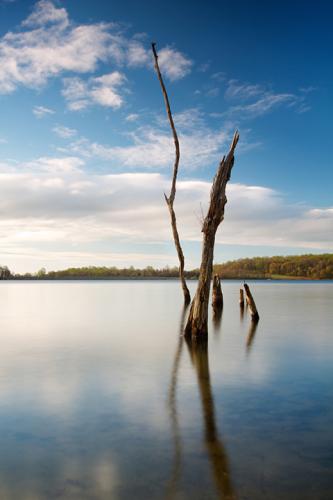
Merrill Creek Reservoir (Image 1) ©Photo Copyright:Lawrence Zink
The image that you see (image1) was a natural progression for me that morning. I worked this spot until I was able to simplify the composition. I found these five trees illuminated with beautiful direct early morning light. The light and clouds were cooperating and my patience paid off as clouds began to drift into the frame. On this particular day the water was somewhat choppy and I found that to be distracting. I used my polarizer with a 2stop Neutral Density filter to create a longer shutter speed that made the water have a glass-like surface. The reflections of the trees created visual leading lines into the image. I have found that having ND filters of all types has made the difference in achieving consistent landscape images. Graduated neutral density filters allow the photographer to balance exposure between light areas and dark areas in the composition. Solid neutral density filters will lengthen your exposure without altering color. I use a variety of Singh-ray filters depending on the conditions. It's not a deal breaker to get a good image but if used well it will limit your time at the computer trying to correct. To be honest, I'm one of those guys that want the image as good as possible before any additional work is needed in Photoshop.
Teetertown Preserve
Traveling east from Merrill Creek through beautiful rolling hills and farmland we arrive at our next destination: Teetertown Preserve. Teetertown Preserve is a hilltop preserve encompassing 686 acres. Our destination though is the cascades of Hollow Brook. On the edge of the preserve there is a steep ravine where Hollow Brook slowly makes its way down the mountainside. For most of the year these cascades do not provide much action, but in early spring or after large rainstorms these cascades are fun to shoot. It’s even more fun since a small, very tight gravel road parallels the stream as it heads to the top. For newcomers, it provides a quick way to survey for a prime location. A pretty stone bridge anchors the bottom of the brook and provides an idyllic view of the mountain cascades. Interesting boulders, moss covered rocks coupled with rushing water is a good starting point in my photography world. Whenever possible, overcast skies provide the best light to shoot cascades. Direct sunlight and water creates too much contrast to get a beautiful image of moving water. Want something even better? Shoot right after it rains.
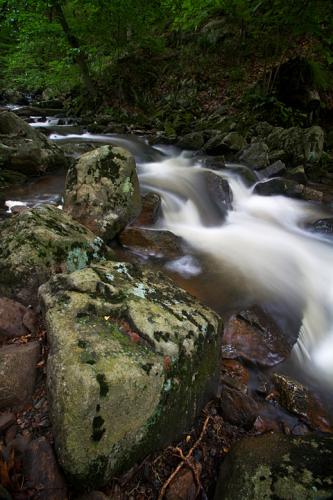
Hollow Brook Cascades, Teetertown Preserve (Image 2) ©Photo Copyright:Lawrence Zink
With the image shown (image 2), I wanted to emphasize the environment around the creek rather than the water itself. A good composition has a beginning, a middle and an end. It leads the viewer in and around the image. If possible, I always try and anchor the bottom of my image with something, in this case the three rocks. The rocks create a balance within the shot and lead the viewer to the water and beyond. It's a consistent theme in most of my photography. The strong diagonal of the stream directs the viewer up and down the image. To achieve the water movement is a matter of controlling your shutter speed. The amount of blur versus the length of shutter speed will produce different results. You have the ability to freeze the water or make it seem like cotton. Experiment until you get the results you want. In this image it was for 4 seconds.
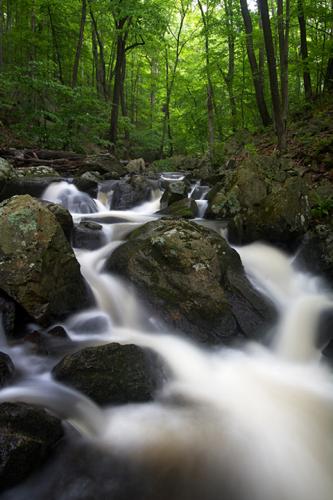
Heavy Cascades at Teetertown Preserve (Image 3) ©Photo Copyright:Lawrence Zink
The second image (image 3) is about the water flow. When I was figuring out this composition I realized that I would have to get wet if I wanted to get the composition I envisioned. I wanted the water to dominate the foreground and lead the composition back to the smaller cascades and rocks. Always safety first but every now and then you may get your legs and feet wet.
Before we continue on to the next location I’d like to offer a technique that I use 100% of the time. I mention it because it makes shooting easier and allows for better evaluation of the shot from a compositional point of view. The Live view mode setting on your camera allows the photographer to perform critical focus, see the effects of filters in real time, check exposure and study a composition. Using the LCD screen as a view finder is a great way to shoot landscapes. Personally, I rarely crop images in post production. Therefore, seeing that image big on the camera is important to me. In a world of immediate satisfaction, it’s nice to take a moment and look at your efforts. My photography career began by shooting 8x10 large format, so understandably, Live view harkens back to those days. The only drawback is shooting in bright light. Those conditions could make it harder to see the LCD on the back. There are commercial products to help solve that problem. They attach themselves on the back of the LCD screen like a giant loupe. I prefer to go low tech--I use my baseball hat and hands. Cheap and somewhat effective.
Ken Lockwood WMA
From Teetertown the roads twists and turns through the beautiful countryside, passing through small villages and beautiful scenery as we head to Ken Lockwood WMA. Ken Lockwood is one of the most beautiful locales in the state. It’s a deep ravine lined on both sides with tall hemlocks. As you walk the 2 1/2 mile path that parallels the river, the hills rise up around you. The sounds of the south branch of the Raritan River are ever present as it rambles downstream. Large boulders are strewn everywhere. Those boulders offer photographers ample opportunities to include them in creating good compositions. Any season is good to shoot here but my personal favorites are spring and fall. In the springtime the water is high and fast and in the fall the colors are outstanding.
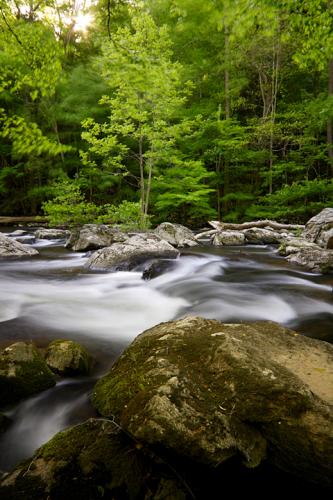
Lockwood scenery, Ken Lockwood WMA (Image 4) ©Photo Copyright:Lawrence Zink
With the first image ( image 4) I took a different tact in photographing in the ravine. I wanted to create a layered composition. I see this shot as 4 planes with the rocks in front (there is that compositional anchor again), the water, the next set of rocks and finally the trees. I think it clearly shows what the beauty of this area is all about. This image was taken in the early spring and the wind was gusting heavily down the river. I like the trees moving because I think it adds to the raw energy of this beautiful area.
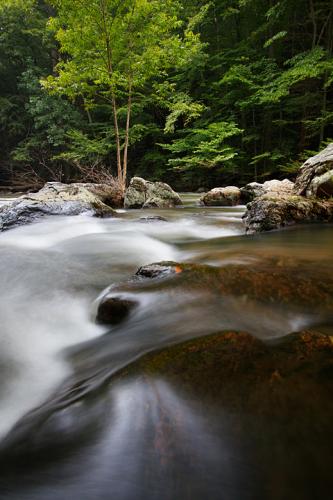
Crossview of river, Ken Lockwood WMA (Image 5) ©Photo Copyright:Lawrence Zink
The second image ( image 5) was shot on a rainy morning in the gorge. The water was running high and the cascades were beautiful. The color of the rocks both above and below the water caught my eye. I positioned the camera low above the water while I had a polarizer on since I originally wanted to lose the reflections to see the rocks. As I was turning it, I saw that it was leaving the white reflection at the bottom. That reflection became an important addition to the composition.
Round Valley Recreation area
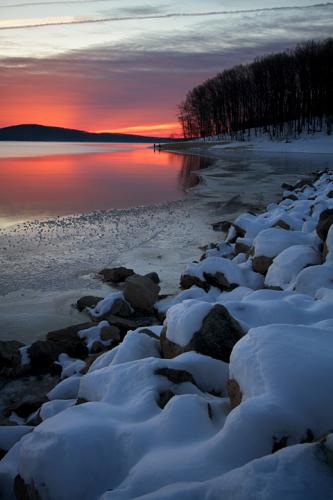
Cold dawn at Round Valley (Image 6) ©Photo Copyright:Lawrence Zink
It’s time to pack up the equipment, roll down the windows and head about 25 minutes south to Round Valley Recreation area. At 2000 acres, it offers up many hiking trails, trout fishing and wilderness camping. Round Valley is the deepest lake in New Jersey with crystal clear water. Most of the natural lakes that exist in New Jersey are in tighter quarters surrounded by tall trees. Those are beautiful in their own ways, but Round Valley is spacious with small rounded hills on its perimeter. Very different for New Jersey. A good image can happen throughout the year here and it allows the photographer to use a complement of lenses. I tend to use wide angles for most of my images but there are locations in Round Valley where longer lenses can be used to isolate compositions. I've been on a sunrise kick here the past couple of months. The perfect vantage point for the sunrise is from the boat landing area. The main park, in season, doesn’t open until 9am but the boat launch is always open. As was the case with this location, I always try to get in position at least 30 minutes before the sunrise. The best light will happen before the sun hits the horizon or it sets below the horizon. You may hear it referred to as magic hour or magic light. Call it what you will, but this type of light bouncing upwards into clouds and illuminating your subject matter can be extraordinary and in some cases breathtaking. It is the ultimate prize for photographers getting up at ridiculous hours in the morning and chasing that elusive light.
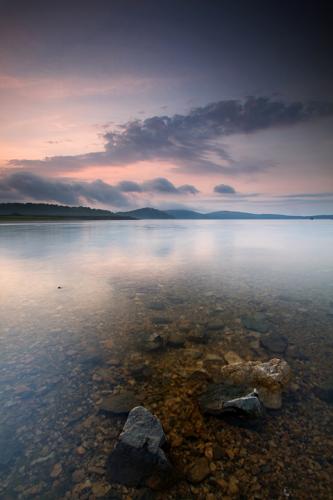
Glassy Lake, Round Valley (Image 7) ©Photo Copyright:Lawrence Zink
I’ve included two images (images 6 and 7) that show the possibilities of this location. Each image is of the sunrise from the boat launch location. The first image (image 6) was taken after one of the big snow storms last winter. It was a cold February morning and it had been cold for weeks--so I was hoping for parts of the lake to be frozen. Compositionally, I positioned the camera to use both the snow-covered rocks and the frozen water as leading lines in the image. Everything is leading to an intense light show as the sun was rising beyond the hills. While not my intention when I set out, the two fishermen on the point add a human scale to the image. This image is a perfect example of a spot to use neutral density filters. I used a 2 stop reverse graduated filter to control the brightness of the sky. Without the filter I would have to expose for the sky because it’s bright and the foreground would be to dark. This filter balances the exposure so I can get it in one shot.
The other image(image 7) was taken this past summer. I knew that I wanted to showcase the clear water and the rocks below the surface. I found a spot that had some rocks peeking above the surface to add some interest to the bottom of the frame. A combination of a polarizer and the 2 stop reverse graduated filter brought the entire image together. The sunrise wasn’t the most spectacular I’ve ever seen, but the subtle hues add to the quiet simplicity of shooting at Round Valley.
I hope that you’re inspired to head out and see these beautiful parks. If you see some gray haired guy (premature) with a baseball hat on (most likely Kenny Chesney), good chance that it’s me. Stop by and say hi. See you out there.
About Lawrence Zink:
I've been in the photography field for close to 30 years. Having graduated with a B.F.A from Rutgers University my career went from shooting editorial portraits for magazines to creating studio images with 8x10 large format cameras. For the past 25 years I've been involved in many capacities producing photography for Macy's. My current position is as a V.P in charge of photography and pre-press. I oversee one of the largest and best equipped photo studio's in the country. For the past 3 years I've taken my passion for photography outside to shoot landscapes. My main concentration has been in New Jersey and all that it has to offer. These efforts are going to culminate with a book being published by Schiffer Publishing. It will be available in the spring of 2012.
To see more images or contact me please visit my website.
